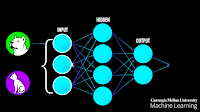07/03/2023
TIGA TEORI EKONOMI DIGITAL
Salam Hangat !'Percikan bunga api itu bisa membakar ilalang'.
Bunga api hanyalah sebuah percikan, namun berpotensi membakar segala yang ada disekitarnya. Upaya sekecil apapun harus tetap dilakukan untuk tercapainya sebuah transformasi diri menjadi lebih sempurna dan menyempurna setiap hari. Mengawali Materi yang sederhana ini, beberapa referensi dalam materi ini dapat disimak pada setiap link yang ditautkan. Dua rujukan utama tentang Model Bisnis Digital, Inovasi, Transformasi Digital, dll. Dapat disimak di digitalleadership, digital business model dan juga di harvard business.
 Disruptive innovation is the process in which a smaller company, usually with fewer resources, is able to challenge an established business (often called an “incumbent”) by entering at the bottom of the market and continuing to move up-market ~Christensen~
Disruptive innovation is the process in which a smaller company, usually with fewer resources, is able to challenge an established business (often called an “incumbent”) by entering at the bottom of the market and continuing to move up-market ~Christensen~- New product development: creating entirely new products or services that meet needs not currently being served by existing products
- Product improvement: enhancing existing products or services to improve functionality, quality, or performance
- Line extensions: introducing new variants or versions of existing products to the product line to appeal to different customer segments
- Repositioning: changing the target market or value proposition of an existing product meet customer needs better
- New technology development: creating entirely new technologies that can be used to solve existing problems or meet new needs
- Technology improvement: making enhancements to existing technologies to improve their performance, reliability, or efficiency
- Technology integration: combining different technologies to create new solutions or applications
- Disruptive technology: creating new technologies offering a radically different value proposition
- New business models: creating entirely new business models that can be used to solve existing problems or meet new needs
- Business model improvement: making enhancements to existing business models, improving their efficiency, effectiveness, or sustainability
- Business model replication: adapting successful business models from one market or industry and applying it somewhere else
- Disruptive business models: creating new business models that offer a radically different value proposition
- New process development: entirely new processes are created that can be used to solve existing problems or meet new needs
- Process improvement: enhancements made to existing processes improve their performance, reliability, or efficiency
- Process integration: different processes combined to create new solutions or applications
- Disruptive process: a radically different value proposition is offered by newly developed processes
- use of social media platforms
- personalized advertising
- influencer marketing
- Gamification
- virtual reality
- augmented reality
- development of new marketing channels (such as mobile apps, chatbots, and voice assistants)
- introduction of new services
- improvement of existing services
- integration of technology into services
- customization of services to better meet individual customer needs.
- the adoption of new management practices
- the implementation of agile methodologies
- the creation of cross-functional teams
- the use of artificial intelligence and machine learning
- the development of new business models
- the promotion of creativity and risk-taking within an organization to encourage employees to generate new ideas and solutions
Amabile, menyatakan bahwa :“Innovation is defined as the successful implementation of creative ideas within an organization”.
Oleh karena itu kepemimpinan (leadership) merupakan faktor paling penting yang mempengaruhi inovasi. Hal ini dapat dilihat melalui pengaruh kepemimpinan pada karakteristik organisasi seperti budaya, strategi, struktur, sistem rewards , atau sumber daya (resources), atau melalui pengaruh langsung terhadap perilaku mereka dalam kreatifitas perusahaan (employee’s creativity) dan motivasi.
Market-creating Innovations: Hasil pemikiran yang inovatif mendorong pertumbuhan baru sebagai peluang dalam trend di pasar yang menghadirkan berbagai implementasi baru. Pada jenis inovasi ini, menurut Denning, (2016) dapat mengganggu pertumbuhan perusahaan lama yang tidak memperbarui sistem mereka untuk menghasilkan produk dalam jumlah besar dengan harga yang terjangkau
Sustaining Innovations: Perubahan sangat dibutuhkan untuk menjaga keberlangsungan laju dunia perekonomian dan industri dalam meningkatkan performanya. Hal ini mendorong adanya inovasi dari pihak perusahaan dengan menyesuaikan terhadap kondisi pasar, dimana bertujuan untuk menciptakan produk atau layanan yang lebih baik. Untuk menjaga stabilitas perekonomian, pemimpin perlu memikirkan solusi yang dapat memecahkan masalah dalam jangka panjang dengan menghasilkan produk baru yang berkualitas dengan harga yang sesuai, sehingga selain perusahaan, pihak eksternal berupa pelanggan akan terjamin pemenuhan kebutuhannya dengan pengeluaran yang efisien.
Efficiency Innovations: Pada inovasi ini bertujuan untuk dapat menghasilkan output yang lebih banyak dengan usaha yang efisien. Perusahaan dapat menilai informasi yang diperoleh terkait dengan produktivitas yang berjalan, sehingga dapat mencegah terjadinya penggunaan biaya yang tidak perlu untuk meningkatkan profitabilitas. Kelemahan pada inovasi ini adalah dapat mengurangi jumlah tenaga kerja, seperti contohnya di era 4.0 telah menghadirkan teknologi yang mampu meningkatkan performa perusahaan secara efektif dengan mengefisiensi sumber daya manusia (Moffitt et al., 2018).
Is Uber a Disruptive Innovation?
- Schumpeter considered ‘creative destruction’ the essential fact about capitalism. He popularized the term as a theory of economic innovation and also the business cycle.
- British economist Christopher Freeman, who devoted much time researching the works of Schumpeter, once said:
- “The central point of his whole life work is that capitalism can only be understood as an evolutionary process of continuous innovation and ‘creative destruction’.”
- Schumpeter was what economists today call an Austrian economist. Austrian economics is a school of thought that promotes laissez-faire and liberalism.
- Austrian economists believe that the market can find its own path without government intervention.

File Presentase 3 teori Ekonomi Digital
Paparan: Menelusuri Peluang Bisnis Digutal
Thanks In Advanced

















2 comments:
I hope u can share wth Indonesian language in describe. So, it's sure can get it for all learner.
I think, mixed presentation will help student to growing up their capacity. Thanks
Post a Comment